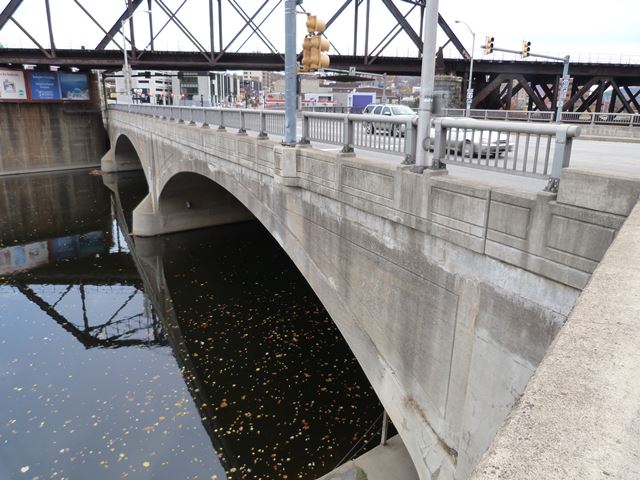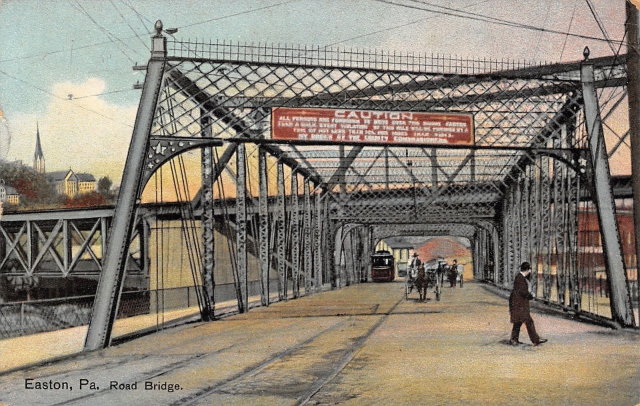We Recommend:
Bach Steel - Experts at historic truss bridge restoration.
BridgeHunter.com Phase 1 is released to the public! - Visit Now
3rd Street Bridge
Dr. George S. Smith Bridge

Primary Photographer(s): Nathan Holth
Bridge Documented: November 7, 2015
Easton: Northampton County, Pennsylvania: United States
1912 By Builder/Contractor: Luten Bridge Company of York, Pennsylvania and Engineer/Design: Daniel Luten
1991
100.0 Feet (30.5 Meters)
300.0 Feet (91.4 Meters)
76 Feet (23.16 Meters)
3 Main Span(s)
28626

View Information About HSR Ratings
Bridge Documentation
View Archived National Bridge Inventory Report - Has Additional Details and Evaluation
View Historical Article About This Bridge After Flood
This bridge is a noted example of a bridge designed by Daniel Luten. The historic bridge inventory dismissed this bridge as "not historic" because it was widened on one side in 1991, 79 years after the bridge was built. However, this widening project actually represents the intent of the bridge's designer, Daniel Luten. A fierce promoter of the concrete arch bridge, he believed his concrete bridges would last much longer than other bridges, and indeed he described his bridges as "permanent" bridges, while condemning other bridge types as "temporary." Luten was particularly critical of pony and through trusses, because they could not be widened to accommodate future traffic. In contrast, Luten pointed out that a concrete deck arch bridge could be widened without demolishing or altering the original bridge, thus extending the usefulness of the original bridge even when traffic needs increased. That this bridge was in use for 79 years, and was widened in 1991, extending the useful service life of the original 1912 portion of the bridge, embodies the design intent of Daniel Luten. As such, this bridge's alterations might be thought of as a demonstration of one of the benefits of concrete arch bridges. Indeed many bridge types built today can be widened in this manner as well, but in 1912, this was much more uncommon, especially for larger, multi-span bridges.
Indeed this exact bridge was used by Daniel Luten in his advertising. Luten took advantage of the railroad bridge at the same location to contrast the bridge designs. Ironically however, the "temporary" railroad truss bridge also remains today! This bridge does not retain original railings, although they appear to have been lost during a major 1955 flood based on a news article.
Above: The bridge appearing in another Luten catalog.
Above: Previous bridge at this location.
Information and Findings From Pennsylvania's Historic Bridge InventoryDiscussion of Bridge The 3 span, 300'-long reinforced concrete deck arch bridge was built in 1912 and widened in kind to the downstream side in 1991. Original concrete balustrades and decorative luminaires have been lost and replaced by low paneled concrete parapets topped by tubular metal railings with bar fill. According to District 5-0 personnel, the bridge was reviewed under Section 106 prior to widening, but no finding was located. No matter the earlier evaluation, the bridge has lost the aspects of integrity because of the widening, replacement railings, and modern development of its setting. The bridge is 1 of 15 deck arch bridges built between 1900 and 1915 in the county. Earlier and more complete examples represent the significance of the bridge type. Discussion of Surrounding Area The bridge carries a 6 lane street with 2 sidewalks over a the Lehigh River on the southern end of Easton. A railroad thru and deck truss steel bridge of the Central of New Jersey RR crosses the river and the bridge at a higher elevation. The area is dominated by late-20th-century commercial development and urban renewal. It does not have historic district potential. Bridge Considered Historic By Survey: No |
This bridge is tagged with the following special condition(s): Luten
![]()
Photo Galleries and Videos: 3rd Street Bridge
Bridge Photo-Documentation
Original / Full Size PhotosA collection of overview and detail photos. This gallery offers photos in the highest available resolution and file size in a touch-friendly popup viewer.
Alternatively, Browse Without Using Viewer
![]()
Bridge Photo-Documentation
Mobile Optimized PhotosA collection of overview and detail photos. This gallery features data-friendly, fast-loading photos in a touch-friendly popup viewer.
Alternatively, Browse Without Using Viewer
![]()
Maps and Links: 3rd Street Bridge
Coordinates (Latitude, Longitude):
Search For Additional Bridge Listings:
Bridgehunter.com: View listed bridges within 0.5 miles (0.8 kilometers) of this bridge.
Bridgehunter.com: View listed bridges within 10 miles (16 kilometers) of this bridge.
Additional Maps:
Google Streetview (If Available)
GeoHack (Additional Links and Coordinates)
Apple Maps (Via DuckDuckGo Search)
Apple Maps (Apple devices only)
Android: Open Location In Your Map or GPS App
Flickr Gallery (Find Nearby Photos)
Wikimedia Commons (Find Nearby Photos)
Directions Via Sygic For Android
Directions Via Sygic For iOS and Android Dolphin Browser
USGS National Map (United States Only)
Historical USGS Topo Maps (United States Only)
Historic Aerials (United States Only)
CalTopo Maps (United States Only)




